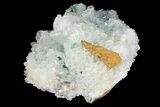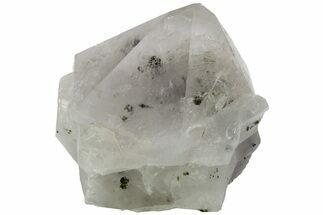This Specimen has been sold.
1.9" Atacamite, Quartz & Selenite Association - Peru
This beautiful specimen contains an association of selenite crystals, vivid green atacamite and quartz. It was collected from the Lily Mine in Pisco Umay, Peru and is 1.9" wide.
Selenite is a variety of gypsum, a soft sulfate mineral that is composed of calcium sulfate dihydrate (CaSO4 · H2O). When chemically pure, gypsum is transparent and colorless, however, impurities give the gypsum a diverse range of colors and formations. Desert rose, selenite and satin spar are just a few of the varieties of gypsum known to have formed though hydrothermal processes.
Atacamite is a secondary copper mineral that's formed from the oxidation of copper minerals. It has the chemical formula Cu₂Cl(OH)₃ and forms as slender prismatic crystals, fibrous crystals and as granular to compact aggregations. Atacamite was first described by D. de Fallizen after specimens found in the Atacama Desert of Chile in 1801.
Selenite is a variety of gypsum, a soft sulfate mineral that is composed of calcium sulfate dihydrate (CaSO4 · H2O). When chemically pure, gypsum is transparent and colorless, however, impurities give the gypsum a diverse range of colors and formations. Desert rose, selenite and satin spar are just a few of the varieties of gypsum known to have formed though hydrothermal processes.
About Quartz
Quartz is the name given to silicon dioxide (SiO2) and is the second most abundant mineral in the Earth's crust. Quartz crystals generally grow in silica-rich environments--usually igneous rocks or hydrothermal environments like geothermal waters--at temperatures between 100°C and 450°C, and usually under very high pressure. In either case, crystals will precipitate as temperatures cool, just as ice gradually forms when water freezes. Quartz veins are formed when open fissures are filled with hot water during the closing stages of mountain formation: these veins can be hundreds of millions of years old.
Quartz is the name given to silicon dioxide (SiO2) and is the second most abundant mineral in the Earth's crust. Quartz crystals generally grow in silica-rich environments--usually igneous rocks or hydrothermal environments like geothermal waters--at temperatures between 100°C and 450°C, and usually under very high pressure. In either case, crystals will precipitate as temperatures cool, just as ice gradually forms when water freezes. Quartz veins are formed when open fissures are filled with hot water during the closing stages of mountain formation: these veins can be hundreds of millions of years old.
Atacamite is a secondary copper mineral that's formed from the oxidation of copper minerals. It has the chemical formula Cu₂Cl(OH)₃ and forms as slender prismatic crystals, fibrous crystals and as granular to compact aggregations. Atacamite was first described by D. de Fallizen after specimens found in the Atacama Desert of Chile in 1801.
SPECIES
Atacamite, Quartz & Selenite
LOCATION
Lily Mine, Pisco Umay, Ica Department, Peru
SIZE
1.9" wide
CATEGORY
ITEM
#98168
 Reviews
Reviews













